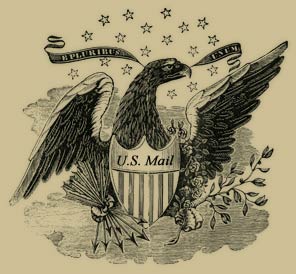The Descendants Of Thomas Sims Graves
of Virginia, Fayette, and Nelson County Kentucky
Relics
Antebellum Mail
 Even before the formation of this great nation the early colonies faced the daunting task of moving both mail and news from one place to another in a timely fashion. This was no easy task considering that the largest part of this nation was uninhabited (except by native American Indians). There were no roads, mostly buffalo trails and even a wagon could not move about easily or over great distances.
Even before the formation of this great nation the early colonies faced the daunting task of moving both mail and news from one place to another in a timely fashion. This was no easy task considering that the largest part of this nation was uninhabited (except by native American Indians). There were no roads, mostly buffalo trails and even a wagon could not move about easily or over great distances.
On July 26, 1775 an act of the second Continental Congress created the position of the first Postmaster General. Benjamin Franklin was appointed to head this endeavor and provided a salary of one thousand dollars a year for his service. This made the current day Post Office Department the second oldest agency or department of the United States Federal Government ever created.
In the early days there were no envelopes, instead a letter would simply be folded and the address written on the outside. Some churches and government organizations would use a wax seal to hold the letter closed.
Postage Stamps became widely available by 1847. You would either purchase a stamp or until 1855 you could have the recipient pay the postage. In 1855 prepayment became mandatory. This was obviously brought about by many an addressee refusing to make payment causing a loss to the Post Office.
A typical letter sent before the Civil War would be handled in this manner. You went to the post office (if there was one) or to the County Clerk and purchased your stamp, addressed your letter on the outside and left it. Once the Postmaster or County Clerk received it the stamp was canceled by simply writing cancel across it with a Quill pen. Your letter may have set for sometime before it was actually picked up.
Early methods employed a horse and rider with a mailbag. Thus the creation of the famous “Pony Express”. Contrary to all the hype and legend they only existed approximately nineteen months. A milestone was achieved in March of 1861 when President Abraham Lincoln’s inaugural address was delivered from St. Joseph Missouri to Sacramento California in a mere seven days and seventeen hours. As stage coach routes evolved it was more efficient to send the mail by coach. Then as the railroads evolved large amounts of mail and goods could be moved over great distances at previously unheard of speeds.
In many a rural type setting once your mail arrived, it was routed to the Postmaster or the County Clerk. There was no mail delivery! So there were mainly two methods of retrieving your mail. When you came into town you went and asked for it. Another method would be the printing of unclaimed mail in the local paper. Hopefully you would see your name in the paper or your neighbor might see your name and notify you that you had mail at the post office or courthouse.
Mailboxes came on the scene in the late 1850’s in major cities. Before the end of the Civil War nearly 50 of the nation’s largest cities had free city delivery. From this point forward the expansion was slow and it was nearly the turn of the century before farmers and others in rural areas actually had their mail delivered.
(Last modified: Feb 3rd 2014, 05:01)
Back to Top